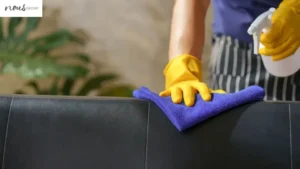Mold can be an incredibly troublesome issue to deal with in any household. Not only does it cause unsightly discoloration and odors, but it can also be hazardous to your health.
Fortunately, there are several ways you can get rid of mold on a sofa. With the right materials and techniques, you can effectively remove all traces of mold from your furniture in no time!
In this article, I’ll walk you through the process of How To Get Mold Out Of Sofa, including harnessing vinegar power, creating a bleach solution, calling a mold remediation company, exposing the sofa to sunlight and vacuuming up remaining particles.
Thus, let’s get started with Nousdecor!
Key Takeaways of How To Get Mold Out Of Sofa
- Wipe down the sofa with a detergent-water mixture before using vinegar and warm water on affected areas.
- When using bleach, test a small area of hidden fabric before applying the solution and gently scrub the mold stains.
- Different cleaning solutions are recommended for different materials, so be sure to check care instructions.
- Regular maintenance, cleaning, and moving furniture outdoors can help prevent mold infestations.
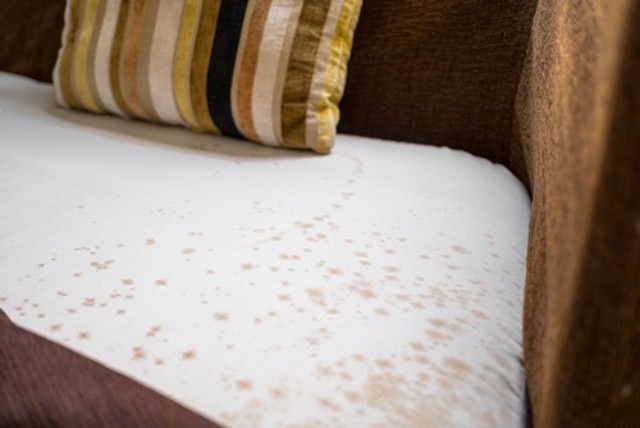
Required Materials
You’ll need a few basic supplies to get rid of that mold, so gather up some rubber gloves, a face mask, and a bucket of warm water with a mild detergent before you get started.
To protect your skin and lungs from the mold spores, make sure to wear the gloves and mask throughout the process.
Additionally, if you have any rags or sponges lying around, grab those as well – they will come in handy for scrubbing away at stubborn patches of mold. You may also need some baking soda and vinegar for later steps in this process.
Once you’ve gathered all of your materials together it’s time to start no steam cleaner sofa cleaning! Begin by using the detergent-water mixture to wipe down the entire surface area of your sofa where there is visible mold growth. Be sure to use circular motions while scrubbing away at those areas.
If the mold is a product of some chocolate stains, however, check out our article on Get Chocolate Off Sofa now for more cleaning tips!
Afterward, you can check out how much progress you have made – if there is still noticeable discoloration on your couch then it’s time to bring out the big guns: vinegar!
Harness Vinegar Power
Harness the power of vinegar to protect your furniture from pesky mold! Vinegar is an all-natural, affordable solution that can be used for a variety of tasks like washing fruits and vegetables, making salad dressing, and even removing stubborn stains.
When it comes to removing mold from your sofa, vinegar is a great option because it won’t harm the fabric or the color of the material. Here’s how you use vinegar in four simple steps:
| Steps | Description |
|---|---|
| 1 | Vacuum your sofa thoroughly to remove any surface debris. |
| 2 | Mix one part white vinegar with two parts warm water to create a cleaning solution. |
| 3 | Dip a cloth into the solution and wring out excess liquid before wiping down affected areas. Allow the solution to sit on the area for at least 10 minutes before rinsing with clean water and drying completely. |
| 4 | Repeat as necessary until all signs of mold are gone. You may need to repeat this process several times for stubborn stains or larger patches of visible mold growth . |
Vinegar has natural antibacterial properties that make it an effective tool against eliminating most types of bacteria, viruses, fungi and other organisms that cause smells and discoloration in fabrics over time.
Furthermore, its acetic acid content helps break down dirt particles which makes cleaning easier without leaving behind any residue or harsh chemicals that can damage materials longterm. With regular maintenance using vinegar solutions you can keep your sofa looking fresh and free from mildew!
Using bleach is another powerful way to eliminate unwanted mold in upholstery fabric but should always be done carefully as bleach can alter fabric colors if not used correctly.
Bleach Solution
Before attempting to clean a sofa with a bleach solution, it’s important to check the care instructions first. Once you have determined that it is safe to use bleach, mix a solution of one part bleach and four parts water.
Apply the solution liberally to the stained area and work into the fabric with a soft scrub brush or sponge. Finally, rinse off the fabric with plenty of cool water and allow it to air dry.
Step1: Check instructions first
Check the instructions first, and don’t be afraid to take a moment to think before you act. Before attempting any cleaning technique on your sofa, it is important to make sure that you understand all of the cleaning requirements.
If there are any warnings or special instructions about the type of easy sofa cleaning solutions or methods to use, read them carefully.
| Material | Cleaning Solution |
|---|---|
| Fabric | Mild Soap |
| Leather | Denatured Alcohol |
| Wood | Vinegar |
| Metal | Baking Soda |
| Plastic | Lemon Juice |
In general, for fabric or microfiber sofas (see How To Clean Microfiber Sofa), a mild soap and water solution can be used; leather sofas require denatured alcohol; wood frames need vinegar; metal pieces should be cleaned with baking soda; and plastic parts can benefit from lemon juice.
Knowing which cleaner works best for what material is key to safely removing mold without causing additional damage, they are sofa itch relief methods as well. With this knowledge in hand, you’re ready for step two: mixing a bleach solution.
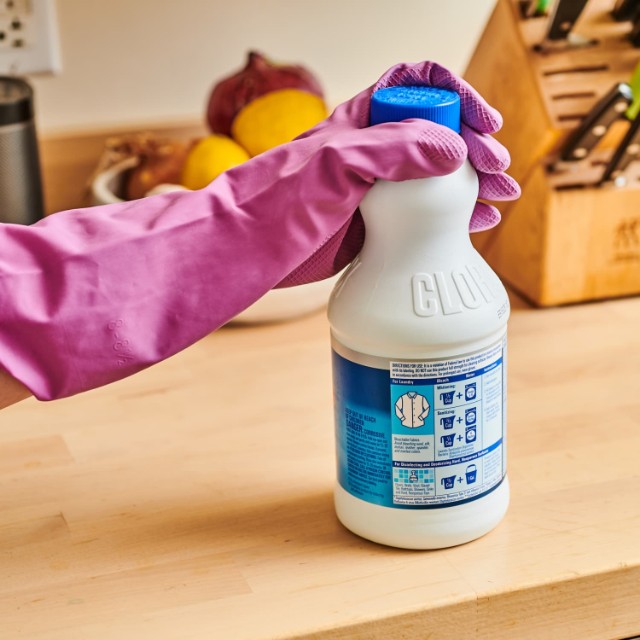
Step 2: Mix a bleach solution
Mixing a bleach solution is the next step to ensuring your sofa stays mold-free – an essential process for keeping its beauty intact. To make it, mix one part bleach with four parts water in a bucket or bowl.
Be sure to wear rubber gloves and safety glasses when handling the bleach mixture. Before applying the solution, test a small area of hidden fabric on the sofa first to ensure that it does not discolor or damage your furniture.
After diluting the bleach solution, dip a soft cloth into it and gently scrub away any visible mold stains on your sofa’s surface. Once complete, rinse off the affected areas with clean water and let dry completely before continuing on with further steps.
Properly addressing mold growth is key in keeping your couch free from harm and looking its best – so be sure to take extra care when cleaning it up!
Step 3: Apply the solution
Now that the bleach solution has been mixed, it is time to apply it to the mold on the sofa. Before beginning, make sure you have all the necessary materials and tools:
- Materials:
- Gloves
- Sponge or cloth
- Bucket of water for rinsing
- Tools:
- Brush (optional)
- Vacuum cleaner (optional)
Using a sponge or cloth, begin dabbing at the moldy area with your bleach solution. If desired, use a brush to gently scrub away stubborn spots. Remember to be gentle so as not to damage your couch fabric.
Rinse often with clean water from your bucket to ensure no bleach residue remains. When finished applying the solution, let it sit for 10 minutes before continuing on to the next step.
Step 4: Work the stain
After allowing the solution to sit, it’s time to work the stain. Using a soft-bristled brush, gently scrub the area in a circular motion until the mold has been removed. Take extra care with delicate fabrics so as not to damage them.
- Equipment Needed: Soft-bristled brush.
- Time Needed: 5mins
If needed, reapply more of the cleaning solution before brushing again. | Difficulty Level: Easy
Once all visible mold is gone, it’s time to rinse away any remaining residue and cleaning solution from the fabric.
Transitioning into this next step will ensure a complete removal of all mold and complete cleanliness of your sofa.
Step 5: Rinse the fabric
Rinsing the fabric thoroughly is essential to get rid of any remaining residue and cleaning solution for a spotless sofa. Start by running cool water over the area you just worked. Make sure you’re working in the same direction as the fabric fibers to avoid creating a fuzz-ball mess.
If your furniture has removable cushions, it’s best to take them outside or put them in the bathtub so that you can rinse out all of the cleaner completely without damaging your floors. After rinsing, use a clean white cloth or paper towel to blot up excess moisture from the fabric and check for any signs of discoloration.
Once you’ve finished rinsing and blotting, leave it alone for an hour or two before moving onto air drying. That way, you’ll ensure that there are no lingering traces of mold left behind on your sofa.
Step 6: Air dry and check stains
Finally, it’s time to air dry and check for any remaining stains on the fabric. To do this, leave the sofa in a well-ventilated area with plenty of sunlight. Make sure that your sofa is not exposed to direct sunlight, as this will cause fading or discoloration of the fabric.
Once the fabric has completely dried out, take a closer look at it. Check for any new spots or stains that weren’t there before you started cleaning. If you find any, try spot-cleaning them again using one of the solutions above.
When finished, inspect the entire couch and make sure all mold is gone and no new spots have appeared. After checking for any remaining stains or signs of mold, your sofa should be ready to enjoy again!
Moving forward from here means it’s time to consider getting professional help from a mold remediation company if needed.
Mold Remediation Company
Instead of taking the time to try and get rid of mold yourself, why not hire a reputable mold remediation company?
Professional mold remediation companies have the expertise and experience needed to safely remove large amounts of mold from any area of your home. They are also equipped with high-grade tools and products designed specifically for tackling difficult black mold or mildew infestations.
When you hire a professional service, they will first test the air quality in the affected areas. This helps them determine the extent of the damage and what needs to be done in order to restore it. After that, they will identify which type of fungi is present as well as its source.
Once all this is established, they can create an effective plan for removal using specialized treatments tailored to your specific needs.
The process itself involves using industrial-strength vacuums, scrubbing equipment, and strong chemical agents. These are carefully applied so as not to cause further damage while still effectively removing all traces of fungus from your property.
Professional services also offer additional services such as deep cleaning carpets or furniture (see carpet cleaner for sofa cleaning), painting walls, sealing cracks or crevices where moisture can enter, and more if necessary.
Mold remediation companies come highly recommended due to their ability to quickly eliminate existing infestations as well as prevent future ones from occurring in the future. Their knowledge on fungal removal allows them to complete tasks efficiently while providing peace of mind that your property is safe once again from dangerous molds or mildews.
If you’re concerned about the cost, however, check out our article on professional sofa cleaning prices now!
Moving forward without exposing yourself or your family members to potential health risks posed by these fungi is essential – so hiring a reputable remediator should be part of any homeowners’ safety strategy!
With that said though, it’s important not only rely on one solution but rather look into other preventive measures like exposing affected furniture pieces out in sunlight for added protection against outbreaks occurring again down the road .
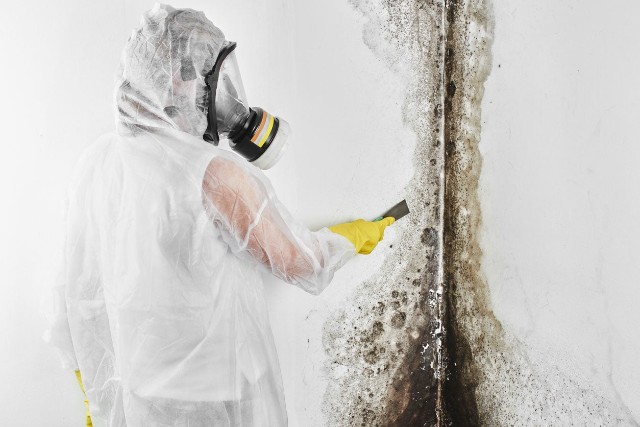
Expose To Sunlight
Exposing affected furniture pieces to sunlight is an effective way to prevent mold outbreaks from occurring in the future. The sun’s ultraviolet rays can penetrate deep into a sofa and destroy any mold that may be present, or prevent it from forming in the first place.
It’s important that you remember to move your sofa outside on a regular basis and expose all sides of the piece evenly. If you can’t move the entire piece out, try to rotate it so each side gets some exposure throughout the day.
You may want to also cover your sofa with a sheet before exposing it to direct sunlight as too much sun could cause fading or discoloration of certain materials.
If there are any visible signs of mold growth, use an upholstery cleaner with anti-fungal properties before exposing your sofa to sunlight. This will help ensure that all traces of mold have been removed and won’t return once exposed outdoors.
Be sure not to leave your furniture outside for more than a few hours at most – too much time in direct sunlight can damage its color and texture over time.
Overall, using natural sunlight is one of the most effective ways to get rid of mold on fabrics like sofas and chairs without having resorting to harsh chemicals or expensive remediation services.
To make sure this method works optimally for you, always remember to practice regular maintenance by cleaning regularly and moving furniture outdoors as needed for long-term prevention against future infestations.
With this approach, you should be able to keep your furniture free from mold for many years down the road. Vacuuming up any remaining particles is another important step towards maintaining a healthy home environment free from contaminants such as mold spores.
Vacuum It Up
Once all the mold has been eliminated, vacuuming up any remaining particles is essential to maintaining a clean and healthy home. To do this, start by selecting a vacuum with good suction power – preferably one that comes with an adjustable head for accessing hard-to-reach areas.
Upright vacuums are best for cleaning large surfaces like sofas, while canister or handheld models are better suited for smaller spaces.
Before beginning, check your vacuum’s filter and make sure it is empty or replaced if necessary. Then, using the appropriate attachments and settings, run your vacuum over the entire surface of the sofa as well as in between crevices and cracks to ensure maximum removal of dust particles.
| Step | Description |
|---|---|
| 1 | Select a vacuum with good suction power |
| 2 | Check the filter before vacuuming |
| 3 | Use appropriate attachments/settings |
| 4 | Vacuum entire surface + crevices/cracks |
It’s also important to consider how often you should be cleaning your furniture – weekly or biweekly is ideal depending on how much use it gets. For those with pets or small children, more frequent vacuuming may be necessary in order to keep dust and other allergens at bay.
With regular maintenance combined with proper care techniques such as spot-cleaning spills as soon as they happen, keeping mold out of your sofa should be a breeze!
Frequently Asked Questions
Conclusion
I’ve gone over the steps needed to remove mold from your sofa.
Harnessing the power of vinegar, creating a bleach solution, and exposing it to sunlight are all effective methods. If you don’t feel comfortable tackling this yourself, consider hiring a mold remediation company. Finally, use a vacuum to suck up any remaining mold spores.
Overall, with enough patience and persistence, you can get rid of that pesky mold on your sofa! If there’s no hope for your sofa, however, just dispose of your old sofa and start choosing the perfect sofa and buy now




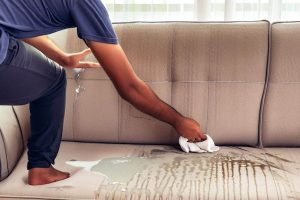
![Sofa vs Couch: Which Is BEST Choice For You? [2024]](https://nousdecor.com/wp-content/uploads/2021/06/Sofa-vs-Couch-300x197.jpg)
